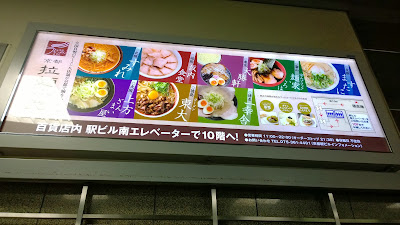We spent Christmas in Kyoto and stayed at Hotel Granvia at the Kyoto Station. Aside from being so convenient for access to Japan's excellent train system, I have a hidden agenda why I always prefer to stay in this area.
On the 10th floor of Kyoto Station is Ramen Alley or Ramen Koji -- one floor dedicated to the business of ramen and ramen alone. And these are not just ordinary ramen restaurants -- there are just eight stores but they represent some of the best regional ramen that you can find in Japan. Much like Ramen Street in the basement of Tokyo Station, Ramen Koji in Kyoto Station has a sampling of the best of the best.
On this trip, I made it a point to try and eat from as many of the ramen restaurants as I could. Hot ramen was also perfect for the 5C Kyoto weather. My first stop for ramen was a familiar name. Kitakata Bannai, a ramen favourite has a branch near our head office in Shiodome.
Like all the ramen shops in Ramen Koji, stores are small with counter seating and a few tables. Thankfully, the queue at Kitakata Bannai is not as long when we drop by for dinner.
Bannai is a ramen chain in Japan that has its roots in Kitakata. Ramen from this area uses a very light broth -- unlike the milky tonkotsu base you find in other ramen bowls.
The light broth is pork based but you get a hint of niboshi or dried sardines, which adds to the depth of flavour of the soup.
Ramen restaurants are always very affordable but Bannai is even more so. We each order the small set which costs just 880 yen each.
The set comes with a bowl of grilled chashu slices over a small portion of rice. The pork belly slices are soft and you can see the glistening, melt-in-your-mouth portion of fat. A teriyaki type of sauce helps ensure that you eat each and every grain of that hot sticky Japanese rice.
I love ajitama eggs! These are soft boiled eggs that have been marinated in a mirin and soy sauce mixture for a couple of days. When halved, the yolks are formed but slightly runny and just the ideal side dish to a hot bowl of ramen.
Now for the main event -- the ramen. One distinguishing feature of Kitakata ramen, aside from the lighter almost clear broth, is the way the chashu is presented.
The pork belly is sliced so that you get both fat and meat and even a thin strip of skin in each slice. While the slices are quite hefty, they are also very tender.
Another distinguishing feature is that the chashu slices cover the whole bowl -- such that you see nothing but pork and broth, all the noodles are hidden underneath -- as you can see from this photo from the menu.
Since we ordered the 880 yen "small" set, the ramen had just 5 slices of chashu. I ate each and every piece -- soft meat, softer fat and slight bit of still crisp skin. Then I wondered how I would have tackled the "large" set where the chashu slices cover the whole the bowl.
But, I must remember that I am no longer as young as I used to be and a bowl of ramen covered with chashu slices may just be the death of pork in the road!
Note : I was so busy eating the ramen that I didn't take enough photos. Credit for photos 5, 6 and 8 go to my son, Gani who is just as hungry for ramen as I am.









wow! I also love ramen :D
ReplyDeletenice post :) #delicious
Thanks so much for your kind comment, Anthony Erick :-) cheers!
Delete